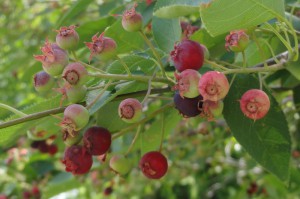Edible Landscapes
Interest in home-grown edibles has never been higher. It’s easy to see why. Organically grown fruits and vegetables are now standard at almost every grocery store. Both scientists and consumers are now starting to appreciate the role that antioxidants play in healthy lifestyles. And there really is nothing quite like eating fresh produce from your own garden.
That said, so many of our traditional fruits require a great deal of time and effort to produce. Aren’t there any low-maintenance plants that produce healthy fruit? … Well, as a matter of fact there are.
Serviceberry (Amelanchier x grandiflora)
Serviceberry is truly an incredible plant. It grows as a large shrub or small tree. It has white flowers in spring and brilliant fall color. A typical serviceberry tree will produce hundreds of delicious, dark red berries each year. They taste somewhat like blueberries, and are packed with antioxidants. The berries typically ripen in June, but this year (2012) they are ripening as we write! Birds love serviceberries so don’t wait too long to harvest! If you manage to be the “early bird,” you’ll be rewarded with a tasty treat.
Aronia (Aronia melanocarpa)
Don’t be alarmed by the common name for this plant: “chokeberry.” Their berries certainly don’t cause choking. However, the taste when raw is a bit astringent. Aronia berries are best when converted into juices, jams or wine. Iowa State University reports that aronia berries are exceptionally high in antioxidants.
Elderberry (Sambucus nigra)
Elderberries are broad-spreading shrubs that are native to Iowa. They have beautiful, cream-colored flowers. The fruit is dark purple and is good for preserves. One notable variety is called ‘Black Lace.’ It’s purple foliage and finely dissected leaves make this plant reminiscent of a Japanese maple. You have to see it to believe it.
Other natives
In addition to the three species mentioned above (all of which we sell at the nursery), there are many plants that grow wild in Iowa that produce edible fruit. These include:
- Black cherry (Prunus serotina). A ubiquitous wild tree that produces thousands of small black fruit every year. Black cherries are packed with antioxidants. And are good for making juice, wine and flavorings. They can also be eaten raw. You must remove the seed however. Incidentally, black cherry trees are also the source for the cherry wood that is so prized by woodworkers.
- Wild Plum (Prunus Americana). This native tree can often be seen growing alongside the road in Iowa. It produces fruit about 1 inch in diameter. The fruit has a distinctive plum taste.
- Gooseberries (Ribes sp). Gooseberries are small shrubs that produce tart fruit. The fruit is delicious in preserves and pies.
- Blackberries and black raspberries (Rubus sp). These lanky shrubs grow freely in Iowa’s woodlands. They produce some of the most delicious native fruit around.
The list goes on and on, and the possibilities are endless. The only question is: How do you plan on enjoying Iowa’s edible landscape?





